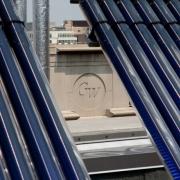Solar at GW
Solar at GW
GW is working to be a leader in solar energy, both through its use and building awareness about its great potential. GW's comprehensive plan for solar energy includes an array of on-campus systems, purchasing energy from dedicated off-campus utility-scale solar farms like the Capital Partners Solar Project, and solar related research and education. GW's investments in solar energy are key components of the University's climate action plan, which provides a roadmap for how GW will reach climate neutrality by 2040.
Capital Partners Solar Project
In June 2014 the George Washington University, in partnership with American University and the George Washington University Hospital, announced a groundbreaking solar project in North Carolina to be developed and operated by Duke Energy Renewables. The Capital Partners Solar Project is a 52-megawatt solar project, which will provide roughly half of GW's electricity needs at a lower cost than conventional energy sources.
Solar Thermal Systems
In 2011 GW installed solar thermal systems on three of its residence halls: Building JJ, Shenkman Hall (formerly Ivory Tower), and 1959 E Street. These solar systems generate about two-thirds of the hot water used in these residences. At the time, these systems were collectively the sixth largest system of its kind in the country, and the largest installation of its kind on the East Coast.
In 2014 GW announced its plans to install solar thermal systems on a fourth residence hall: The Dakota.
The physics behind these solar thermal systems is fairly simple. Collector solar tubes on the roofs of the residence halls absorb and trap sunlight, converting it into heat energy much like a greenhouse. Water is cycled through the tubes in a loop to generate hot water that is then used or stored for later use.
Solar Walk
In 2012 GW completed a "Solar Walk" that connects Exploration and Innovation Halls on the Science and Technology Campus in Ashburn, Virginia. The pedestrian walkway includes a solar-powered trellis and 27 slip-resistant, semi-transparent panels that can convert sunlight into electricity.
Solar Table
A student-led project developed a six-foot-long solar table for the benefit of GW's Foggy Bottom campus student. The surface of the table is made from a solar photovoltaic panel, which collects and stores electricity in batteries inside the table that connects to eight outlets to power electronics.




